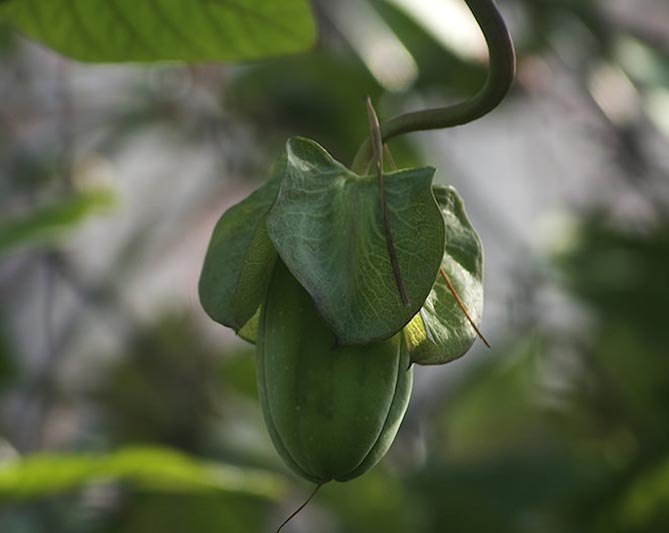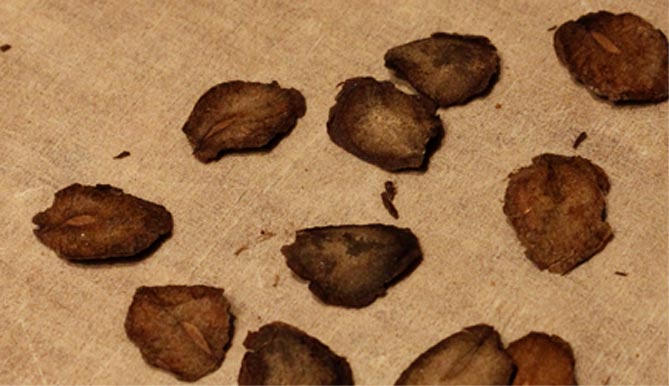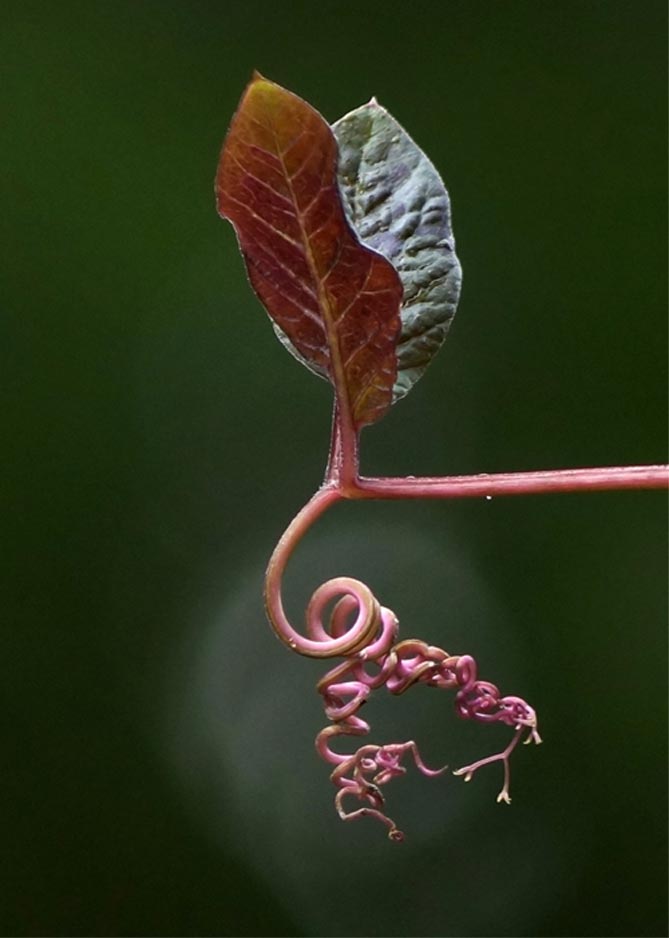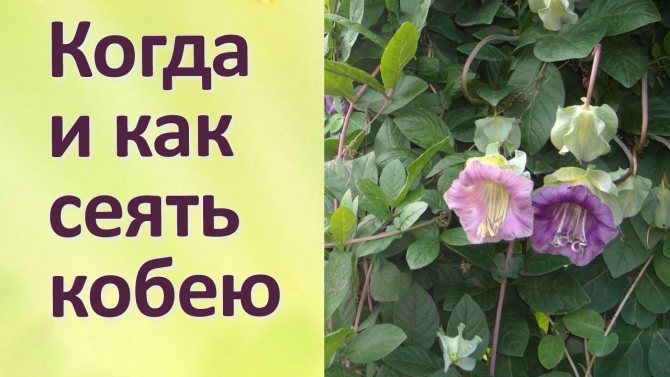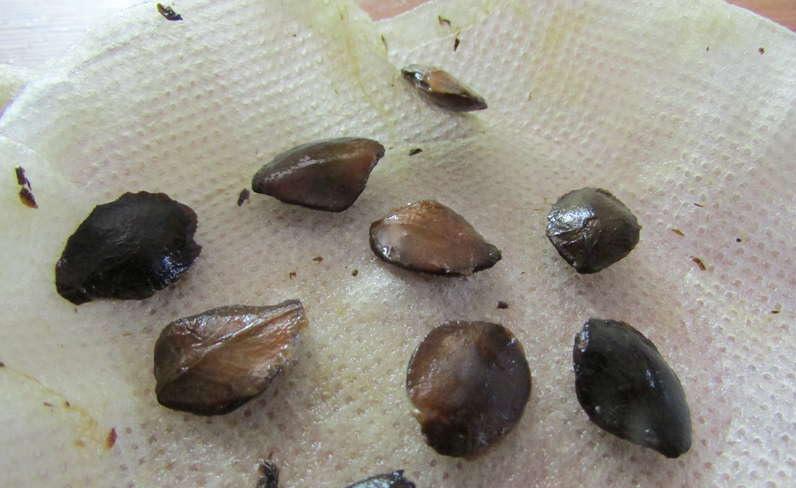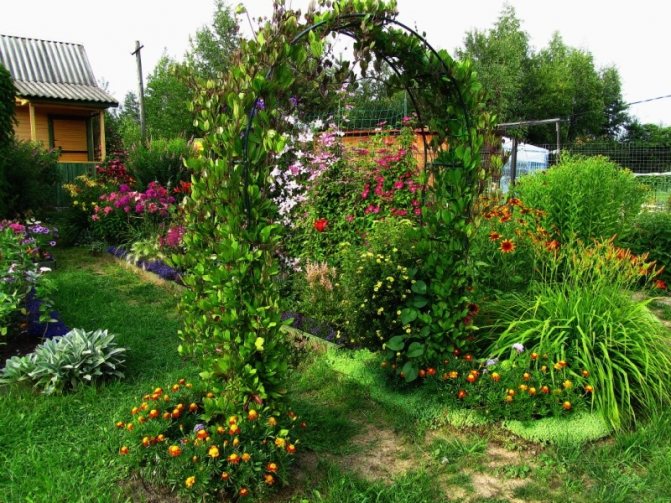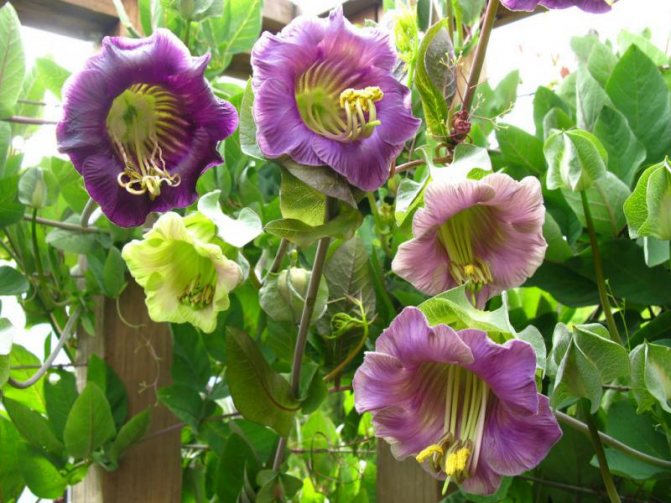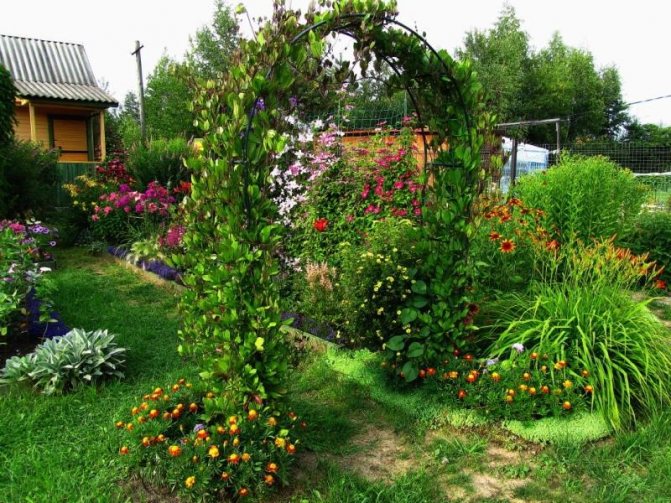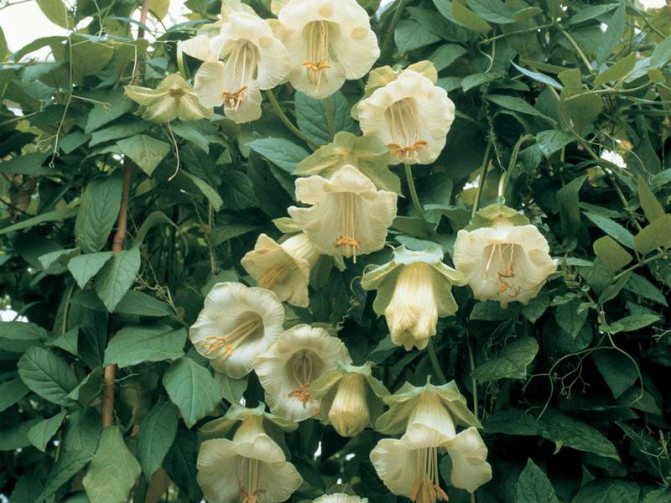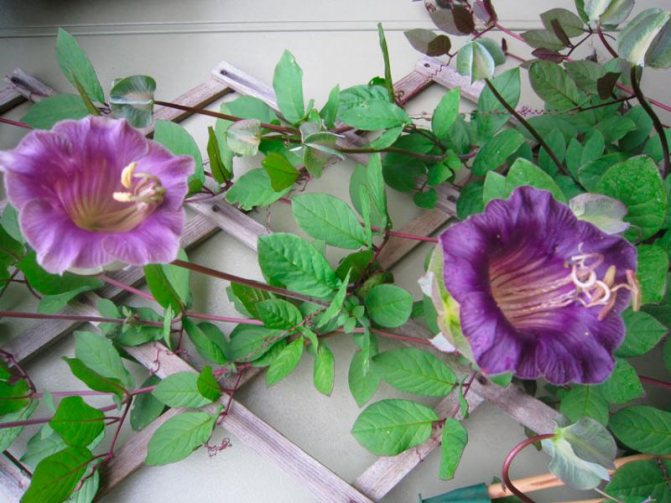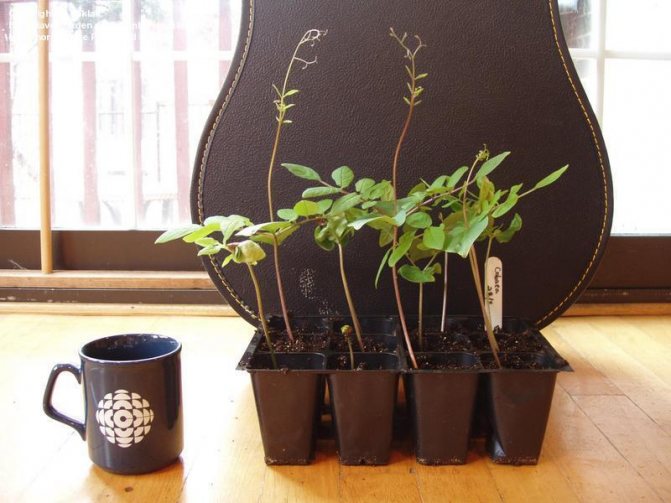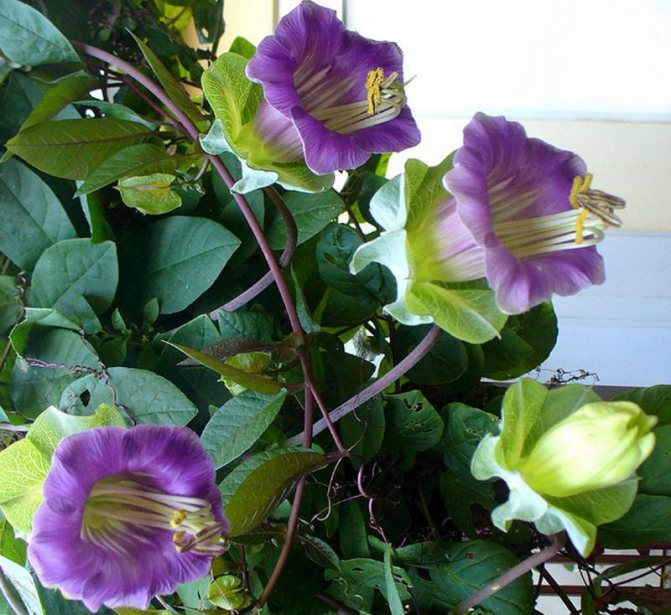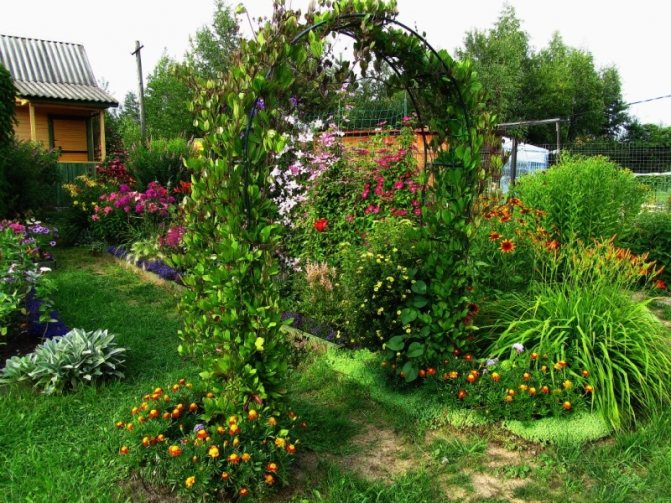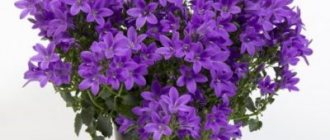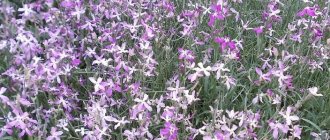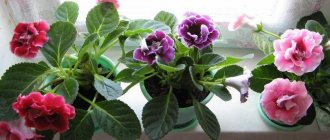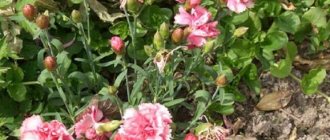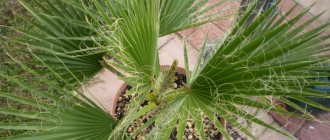The rainforests have given the inhabitants of latitudes with a temperate climate many species of plants that delight the eye with magnificent bright colors. Among them there are many liana-like ones, which have found a place in the gardens. But growing them is associated with a number of difficulties.
The homeland of the perennial kobei creeper is the South American rainforest. In natural conditions, the stems of the plant entangle neighboring trees, decorating them with large flowers and green leaves. No wonder the kobei is called a loach. This is one of the capricious plants that is difficult to maintain in our climate.
Plant from mexico
In our conditions, Cobaea scandens, the climbing kobea, are most often grown. Her name is fully consistent with the plant, she knows how to climb all buildings. Gardeners are delighted with its beautiful flowers and the speed at which the vine grows.
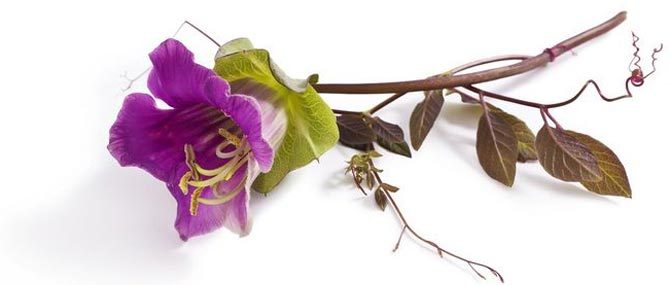
She came to us from Mexico, where her length reaches 30 meters. Belongs to the family Polemoniaceae L. Due to its unique, charming appearance, the plant gains more and more supporters every year.
Botanical characteristics of kobei with photo
| Shoots The plant is distinguished by fast-growing shoots up to 4 meters long. If the cultivation is favorable, the plant reaches a height of 7 meters! |
|
| Flowers The most distinctive feature of this climbing plant is its bell-shaped flowers. Flowers: large, bowl-shaped, planted on long stems, grow individually from the corners of the leaves. They are similar in shape to cups on saucers, hence the English name - cup and saucer vine. They are very impressive - they reach 7 cm in diameter. The most common kobei are white, purple and pink. An additional decoration of flowers is decorative stamens. |
|
| Kobei fruits are distinguished by long flowering - even before the first frost. Fruits rarely develop in our conditions. Sometimes the plant manages to form fruits in our gardens (green plums) from which seeds can be harvested. Under optimal conditions, the fruits are 5-7 cm long and ovoid. |
|
| Seeds Large, brown, flattened (15 seeds / 1 g). |
|
| Leaves Beautiful large, oval leaves of the kobei, with clearly visible veins, which turn red-violet in autumn. Leaves terminate in tendrils. In autumn, the kobea looks attractive not only because of the changing color of the leaves, but also because of the flowers that bloom until October. |
|
Although the flowers appear to be very delicate and fragile, the plant itself is extremely strong and resilient. The main drawback of the vine is that it rarely survives the winter in our conditions. Therefore, it is considered an annual plant. Although the kobei is usually grown as an annual plant, its beauty can be enjoyed in a greenhouse for many years.
Kobey climbing - photo in the garden
Kobei growing from seeds
Some of the problems of growing kobei are associated with one of its natural features - the seeds have a strong peel, which is difficult for sprouts to cope with.
Therefore, before embarking on a landing, it is recommended to prepare them in a certain way:
- Put on the bottom of a wide container, fill with water at room temperature and seal with a lid;
- After 24 hours, release from the softened crust, detaching only its easily peeled parts;
- Seeds peeled in the previous step should be immersed in water until the peel is completely peeled off.
The resulting "clean" seeds will germinate an order of magnitude faster, and if you also use the methods of preliminary germination in foil, described above.
As a result, we will have an intensively developing, strongly elongated, bushy with a lush crown (subject to pinching), a very decorative garden plant. We sow kobei in open ground in June, placing young growth or seeds at a mutual distance of 70-90 cm.
The most significant damage to kobee is caused by ticks and aphids. If the kobeya does not bloom well, this is the first sign of damage by these insects. Spraying with a solution of liquid potassium green soap with phytoverm will help to get rid of them, and the pet flea shampoo copes well with other pests.
This plant is characterized by difficulties in opening the buds, therefore, if they are observed to swell for a long time without opening, they should be carefully cut with scissors.
To reduce the likelihood of not sprouting, you should use the recommendations outlined above, as well as choose seeds from several manufacturers at once in the store and, as an additional measure, water the soil with kobei crops with zircon.
Liana kobea (Cobaea) is a climbing dwarf shrub, which is an annual and belongs to the cyanose family. Gardeners cultivate it as an annual plant. This vine was named after Barnabas Kobo, who was a naturalist monk and lived in the plant's homeland (Peru and Mexico) for several years. In nature, kobei can be found in the humid tropical and subtropical forests of North and South America. Such a plant has been cultivated since 1787, while it is most often used for vertical gardening of arbors or hedges.
Kobei species
Unfortunately, we do not have as many kobei varieties as in Mexico, New Zealand or the Philippines. There are only 3 varieties that differ in color. The most popular purple kobei. An interesting kobei white Alba has beautiful white bells, which are very impressive.
Photo. Alba variety
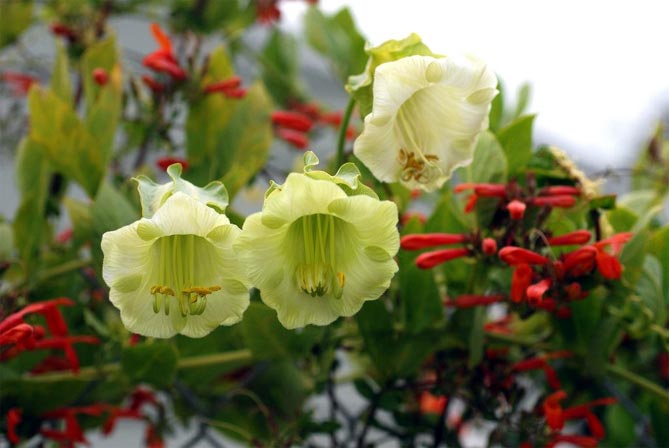

A characteristic feature of this climbing plant is a delicate aroma that is felt especially in the evening. Therefore, it is worth planting it on a balcony or terrace, where there is an opportunity to relax on a summer evening. The feathery leaves are also decorative, at the beginning of the development of the vines they turn green, then they acquire purple-red hues.
In the horticultural literature, you can read that kobei flowers are pollinated by moths and bats.
Kobeya: combination with other plants
Kobeya, both perennial and annual, will become a bright and unique decoration of any site, especially in a competent combination with other plants. Petunia, verbena, lobelia are perfect for her. If you approach this issue creatively and use all your imagination, you can get a fantastic result.
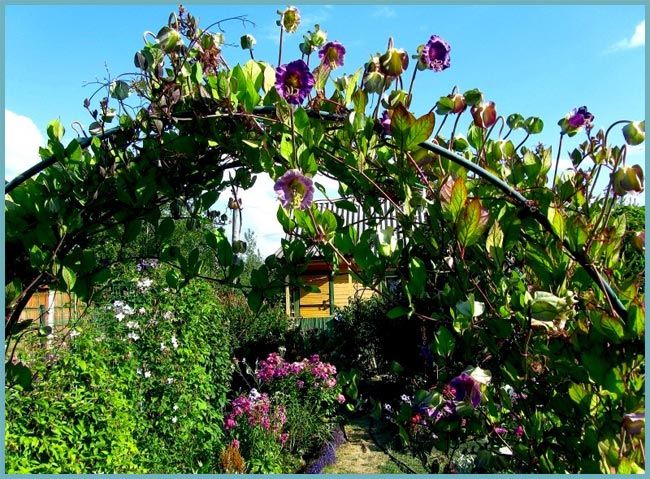

Kobei - decoration of the arch
Requirements for growing conditions
To create ideal conditions for kobei, you need to provide a loamy substrate with enough humus. We must not forget about regular watering. The best landing site is the solar exposure area. This spectacular plant tolerates direct sunlight. The large amount of light stimulates long and abundant flowering of the kobei. Liana feels great in sheltered places, so it is recommended to plant it on a terrace, balcony.
You can take a chance and plant a vine in a shady place. But in the shade, the bell-shaped flowers will not be as impressive, the plant will produce less foliage. Shelter from the wind contributes to a longer growing season because the kobea is not very resistant to low temperatures.
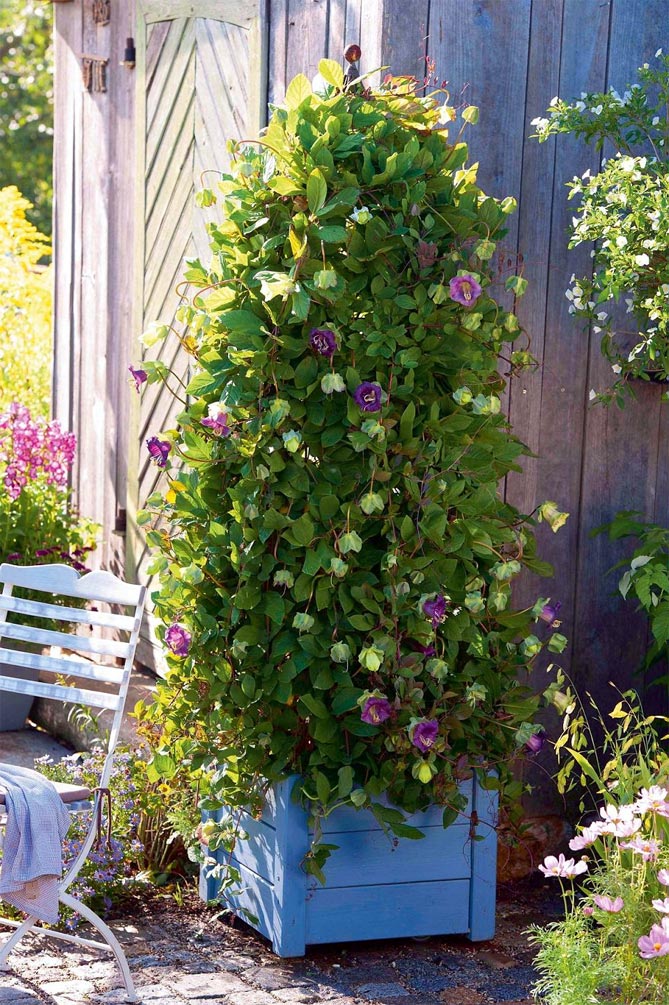

After flowering
Seed collection
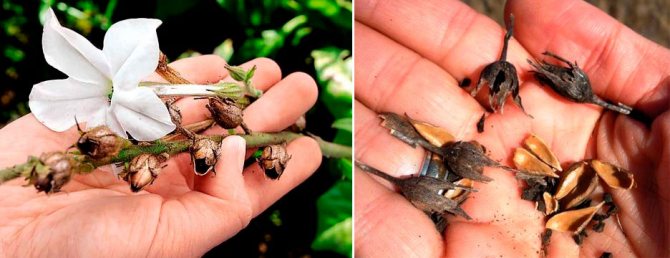

Flowering begins in July and ends with the onset of frost. In middle latitudes, such a shrub is grown as an annual, which means that it should be burned in autumn. Seeds in mid-latitudes do not have time to ripen, so they will have to be purchased again at the store for sowing next year. It should be borne in mind that even if you buy seeds of a well-known brand in a store, their germination rate will not be higher than 30 percent.
If you wish, you can try to keep the grown kobei until next year. In October, you should cut off all the stems from the bush, carefully dig it and plant it in a large box or flowerpot. You need to store such a plant in a cool, dark place, while the temperature should not exceed 12 degrees. So, a basement or cellar is perfect for storage. Make sure that the substrate does not dry out; for this, water it once every 20-30 days. In the last days of February, the first - March, the bush should be rearranged in a bright and warm place and watering should be gradually increased. The bush is planted in the garden only after the threat of frost has completely passed.
Fertilizers and watering
Kobeya grows very strongly and needs abundant fertilization. It is worth fertilizing the plants regularly, at intervals of 2 weeks. Then you can expect a beautiful growth of the kobei.
Photo. Kobei growth in one summer with proper care
It is best to use an all-purpose fertilizer that is rich in all the essential nutrients. Potassium-phosphorus fertilizers or special fertilizers for flowering plants are suitable.
If mineral fertilizers are not applied, you can feed the kobei with nettle broth and add compost.
Even before planting, the substrate can be enriched with organic fertilizers:
- rotted manure,
- compost.
Drought too long should not be allowed. On hot days, increase the frequency of watering. On hot days, potted kobei need to be watered daily. It is important that the pot has sufficient drainage to allow excess water to drain away.
Why do kobei leaves dry? Withering and drying of kobei leaves is usually caused by too little watering or drafts. During the growing season, plants should be watered generously; there should be no drafts on the site.
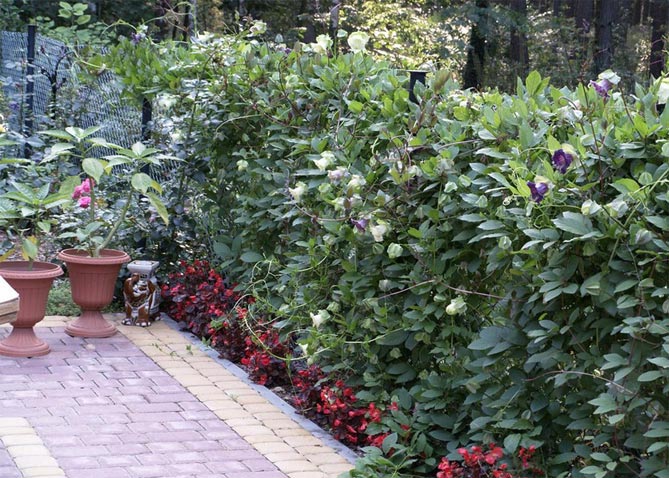

Plant care
Kobeya loves moisture, so watering should be regular, especially on sunny days. However, an excess of water must not be allowed, which can lead to rotting of the roots. Watering should be done after the topsoil is dry.


Nitrogen fertilizer
As soon as the first leaves appear, the plant needs to be fed with a high nitrogen content - this is an important condition for the formation of healthy and beautiful buds. And after flowering, fertilizers need to be changed to phosphorus and potash fertilizers to maintain the health of the flowers. Kobeya is a large plant, so fertilization needs to be applied every two weeks. For the full growth of kobei, it is recommended to alternate organic and synthetic fertilizers.
Mexican ivy is rarely infested with pests and diseases, but for prevention, you need to inspect the plants every week. When aphids or spider mites appear, it is worth treating with any store-bought product.
Loosening the soil and weeding is necessary according to the situation, but these procedures are mandatory during the flowering period, since the weeds take up a large amount of water and nutrients necessary for the healthy formation of petals.
Reproduction of kobei
The plant is propagated by seeds and cuttings.
Growing from seeds
Kobei seedlings are obtained from seeds. The seed pods of the kobei must be dried, then the dark seeds must be collected inside.
You can buy seeds in garden stores or try to collect them yourself from the fruit-boxes. It is important to know when to plant a kobei.Since the period from sowing seeds to the appearance of the first flowers is quite long, it is better to sow seeds for seedlings at the turn of February-March in boxes placed in a warm room. For sowing, use a universal soil. The substrate can be heated in the microwave to kill mold and mildew.
It is convenient to plant kobei seeds in peat pots or tablets. These discs are an excellent replacement for sowing and are very easy to use. Dry discs are moistened with water, they absorb it like a sponge, and then increase their volume. After moistening the disc, we get a ready-made mini sowing pot. Kobei seeds are large, so they are placed in the center of a wet disc, gently covering the top layer with peat or simply pressing it against the substrate.
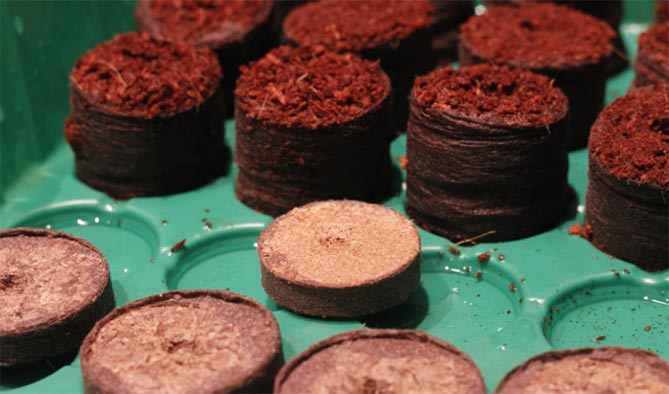

If the kobei is grown for a balcony, in a container, prepare soil well fertilized with compost, which is poured onto the drainage layer. Sand or gravel drainage is very important. Kobei likes permeable soil that is rich in nutrients. The substrate used for container growing can be mixed with sand to aerate the soil. The seedlings should then be transplanted into large pots filled with compost soil. Ultimately, the diameter of the pot should be 20 cm.
Up to 3 seeds are planted in 1 pot. The seeds should be pre-soaked in water overnight.
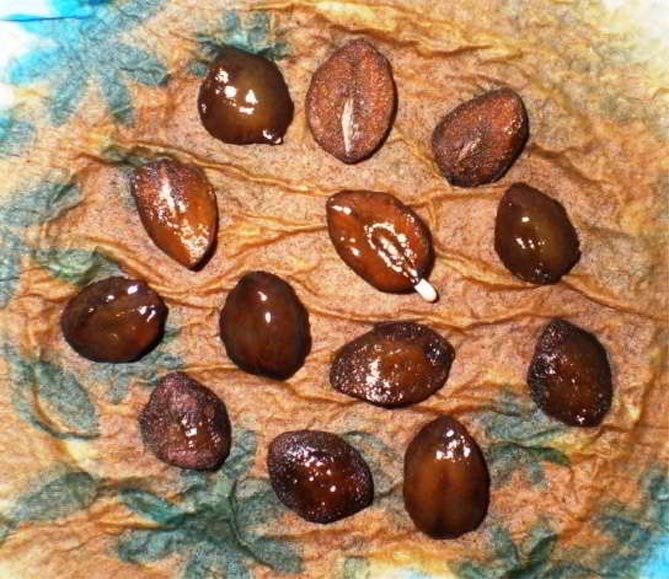

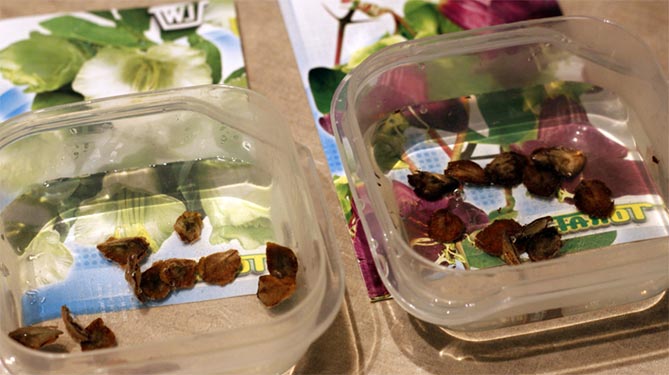

Important! Kobei seeds should be planted vertically, tip up, where the sprout will grow, as shown in the photo below.
When sowing, the seeds are placed only on a damp substrate, slightly pressed into the ground, and sprayed with water. The pots are placed in a lighted and warm place - in a heated greenhouse or apartment, on a windowsill.
The seeds germinate at a temperature of 18-20 ° C. After 3 weeks, shoots can be expected to appear.
A pick is not needed. Kobei can be planted in open ground in the second half of May, when the risk of frost has passed.
Photo report - growing from seeds step by step
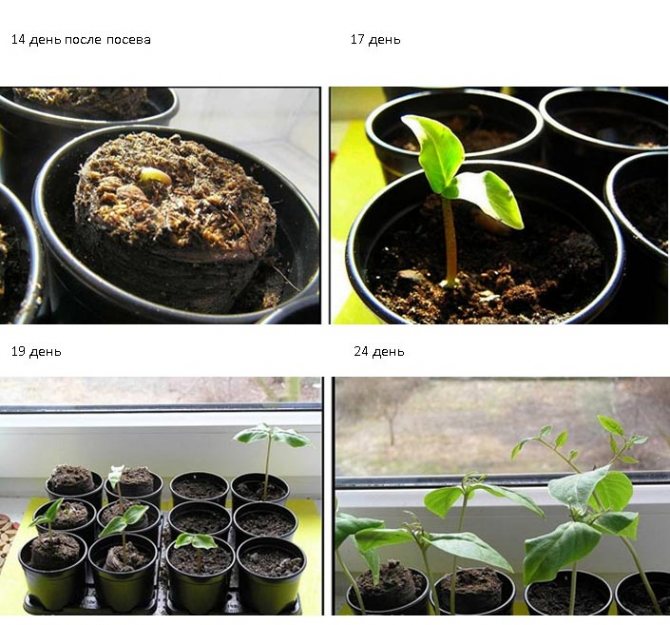

Day 36 - the plant reaches for the sun. The seedling is pinched behind the second knot of leaves.
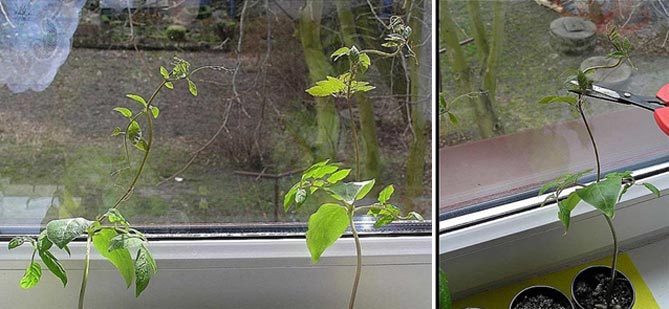

Saplings after pinching.
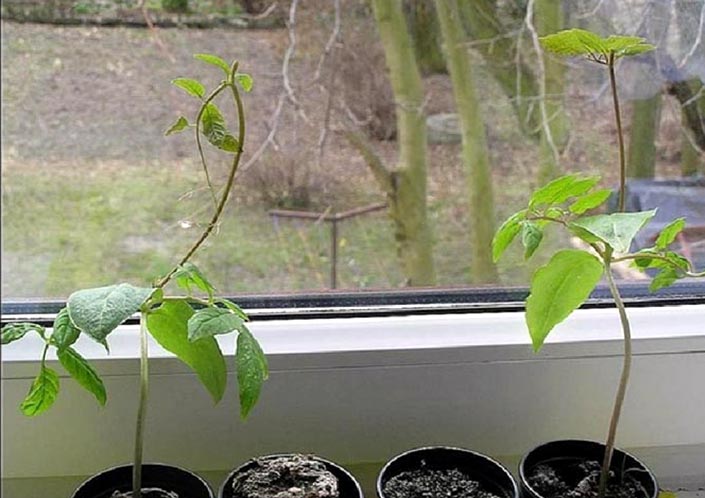

We protect the seedlings with a plastic bottle, not forgetting to ventilate.
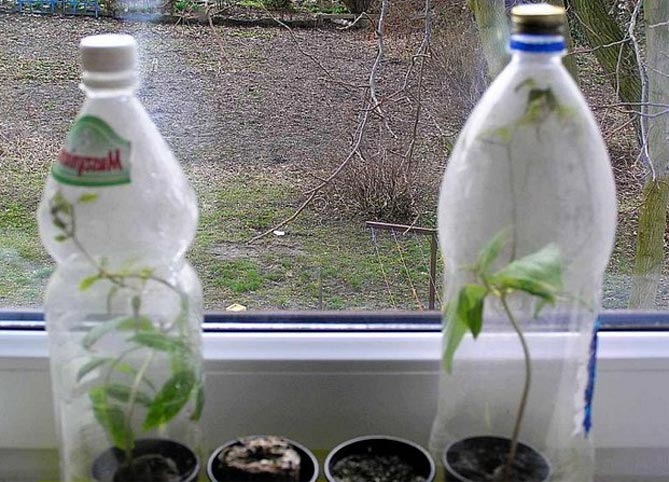

Propagation by cuttings
Reproduction is also possible by rooting young shoots. Cuttings are cut in August or early spring. The twigs are cut under the knot and then rooted in specially prepared pots. Shoots can be rooted in water.
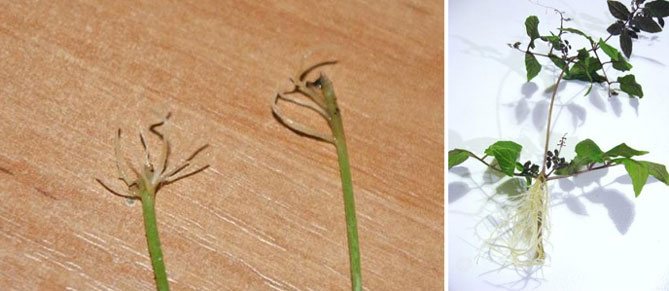

During rooting, the temperature should be 25 ° C, and the cuttings should be covered with a plastic cover to ensure high humidity. Plants grown from cuttings flower slightly faster.
Tip: It is worth sticking a stick next to the cuttings so that they climb from the very beginning. This will help the plant to harden.
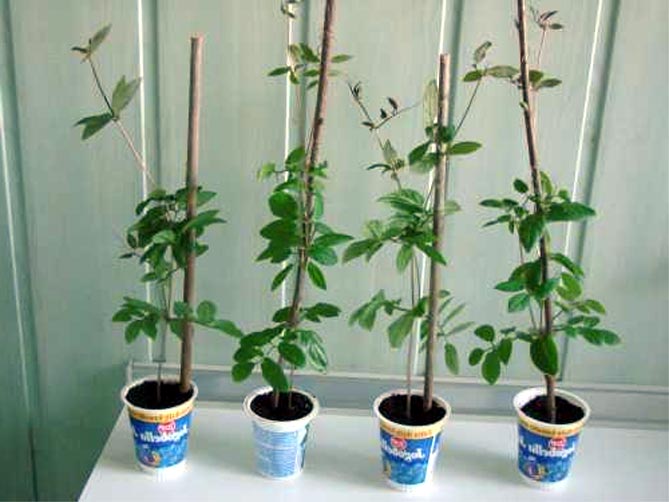

Landing in the ground
Seedlings are planted in a permanent place in the second half of May. First, you need to harden - take out the bushes in pots for a walk outside on warm days, first for 1 hour, then increase the walking time. Compost is added to the planting hole. Part of the earth in the hole and around is mixed with sand.
Planting intervals: 40 × 60 cm.
A good technique is to cut off the top of the shoot of young seedlings, then the plants will grow stronger and grow better. Especially if the gazebo is low or the kobei grows against the wall, it is worth cutting off the tips of the shoots. Thanks to this, the plant branches out, creating a lush shrub.
Kobea blooms 17-18 weeks after sowing.
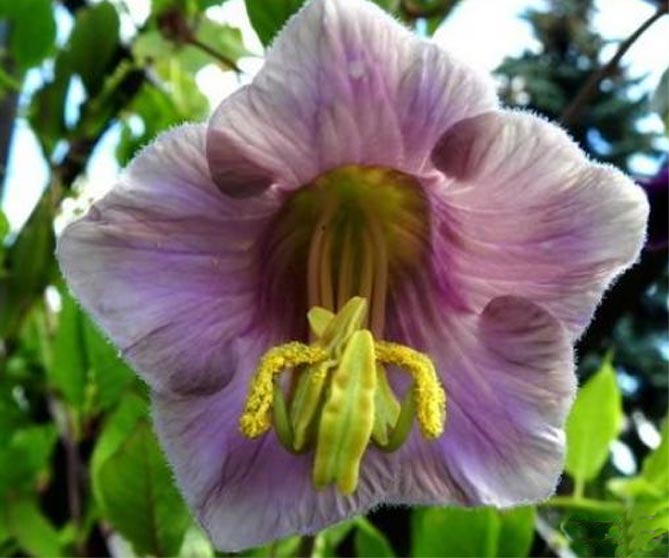

Terms and rules for planting in open ground
Planting of seedlings begins after a stable warm temperature is established during the day, and there will be no frosts at night. Therefore, the timing of planting varies greatly in different regions. In the event that the low temperature lasts until the end of May, the seedlings are nevertheless planted, but subsequently covered with non-woven material to prevent the plants from freezing.
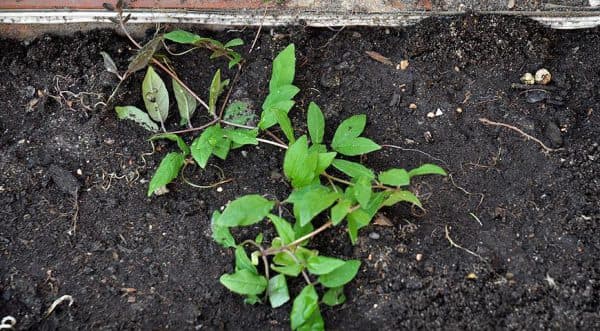

Landing in the ground
As a place for a kobei, a bright area with fertile soil, protected from strong winds and drafts, is best suited. She can survive in the shade, but the shoots will be short, flowering is scarce. When landing, it is recommended to consider the following points:
- it is necessary to plant seedlings at a distance of up to a meter from each other so that the plants receive all the necessary nutrients from the soil;
- before planting, you need to loosen the soil, and add peat, humus and ash to the holes for the seedlings to kill parasites;
- after planting, the plants need to be covered with earth and watered with warm water, while avoiding stagnation of liquid in the soil;
- to keep warm, you can sprinkle young plants with sawdust or a small layer of peat;
- it is imperative to install supports to support the shoots, even if the plant is planted next to a wall or fence.
If you want to get a lush plant, and not a long liana, then starting from two weeks the young need to pinch the tops of the stems. This will allow them to strengthen and avoid intertwining with each other.
Wintering
As mentioned earlier, the cobea, originating from Mexico, is not able to hibernate on its own in the open field in our climatic conditions. However, this does not mean that wintering is impossible. This is a challenge for persistent, patient gardeners.
Kobei can hibernate in a flower pot. Before moving the plant to a cooler room with access to light, all shoots are pruned at a height of about 15 cm from the ground, leaving the main skeleton of the plant intact. Pruning ensures that winter conditions can be tolerated by the kobei in good condition and storage is much easier.
In winter, a period of rest in a cool room is required, at a temperature of at least 5 ° C. Kobei grows less intensively in winter. The plant requires much less watering. In the spring, they gradually begin to increase the dose of water, stimulating the growth of shoots. When frosty days pass, you can put the pots back on the terrace, balcony.
In early spring, the plant should be transplanted into new soil, watered regularly and fertilized moderately (initially) (every 2-3 weeks in small doses). To stimulate growth, the temperature should be raised to 15 ° C. When new shoots appear in the spring, some of them can be used as apical cuttings.
Growing kobei from seeds
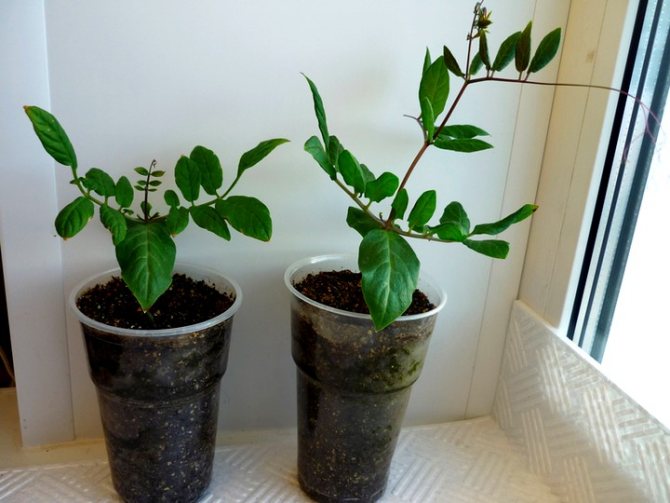

Sowing
It is not so easy to grow a kobei from seeds, but it is quite possible. The fact is that the shell of large seeds is distinguished by a high density, which greatly complicates the appearance of sprouts. Therefore, before sowing, such a shell must be dissolved to such a state that it looks like mucus, and then removed by hand. To do this, you need to spread the seeds on the bottom of the container, which should be wide enough, while taking into account that they should not come into contact with each other. Pour water into the container and close it very tightly with a lid to prevent evaporation of the liquid. From time to time, it is necessary to check the seeds and at the same time remove the sagging part of the shell, and then lower them again into the container. As a rule, it takes several days to completely clear the seeds from the shell.
For seedlings, this plant should be sown in February or the first days of March. For sowing, it is recommended to use individual, not very large cups, in which one seed is placed at a time, thus you do not have to injure young plants during a dive. To sow seeds, it is recommended to use a universal soil. The seed must be laid on the surface of the soil, while the flat side must be turned down, and then sprinkled on top of it with a layer of the same soil mixture, the thickness of which should be 15 millimeters. Seedlings appear after a different amount of time. If you properly prepared the seeds and completely removed the entire shell, then the seedlings may appear after half a month.
Seedling
When the seedlings grow up a little, and they have 2 true leaf plates, they should be dived together with a lump of earth in containers, which should have a volume of about three liters. This will create a strong root system and powerful stems. During transplanting, do not forget to put special ladders made of metal or plastic in the container, in this case the seedling will grow using it as a support. At the same time, you should begin to harden the seedlings. To do this, the plant is transferred to a loggia or balcony, which must be insulated or, in extreme cases, glazed. The plants will stay here before transplanting, while slowly getting used to the cold air. As a rule, three weeks of hardening is enough to get the plants fully accustomed to the outdoor climate. Then you can start planting grown and matured seedlings in open ground.
Diseases and pests
Kobeya looks very impressive, and most importantly, it is extremely resistant to various diseases. Diseases are very rare, occasionally the plant is attacked by aphids and spider mites. Symptoms of pest infestation are manifested in the rolling of the leaves. You need to react immediately using the appropriate drugs.
- Mite. Despite the low air humidity in the apartment, spider mites may appear on the kobei. To get rid of pests, the infected plant should be sprayed with acaricide.
- Aphid. Sticky, distorted leaves are a sign of aphid infestation, which tends to infect kobei shoots in spring and summer. Pest control is carried out with suitable insecticides.
Fortunately, other diseases that affect vines are rare in the case of kobei.
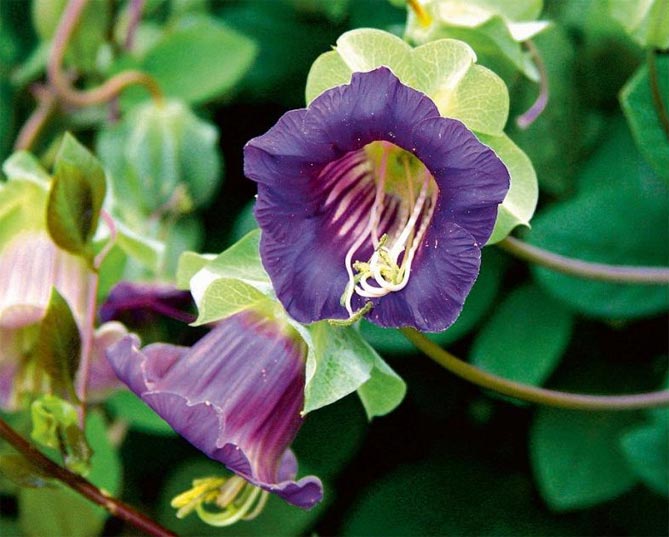

Growing features
Almost every gardener is able to plant this flower on his site. Kobei, (growing from the seeds of this vine requires certain skills) is a light-loving plant. If she can somehow put up with a small penumbra, however, it will not grow in darkening. Therefore, you should choose a sunny place on the site.


The soil should be fertile and well fertilized. Also, the plant loves wet soil. However, over-watering, like most plants, causes rot. In this case, the plant is attacked by pests (mites or aphids). Therefore, maintaining a certain level of humidity is extremely important for kobei.
Landscaping use cases - photo
This plant can be easily found in gardens, terraces. Kobei has certain requirements, but should not create any special problems when leaving. It is convenient to grow a kobei in a pot. Then taking care of the vine will not create problems. In this case, you can move the pot indoors, protecting the plant from the winter period.
Kobei looks beautiful on:
- all kinds of pergolas,
- fences,
- gazebos,
- props on the walls of buildings.
In the case of growing kobei as a houseplant, the liana is provided with a support and placed in the chosen place. Several kobei, planted with their stems enveloping the window, will create a spectacular green curtain, adorned with colorful flowers in summer. Plants are best placed in a flower box or hanging baskets.
Thanks to the kobei, we will bring a little exoticism to our garden. A leafy vine will provide excellent sun protection. The plant can be used as a natural barrier from the prying eyes of passers-by and neighbors. With the help of liana, you can easily zone a plot, a terrace, a balcony, creating a climatic corner designed for relaxation. An interesting source of inspiration can be a combination of several pots in which different varieties of kobei will be planted.
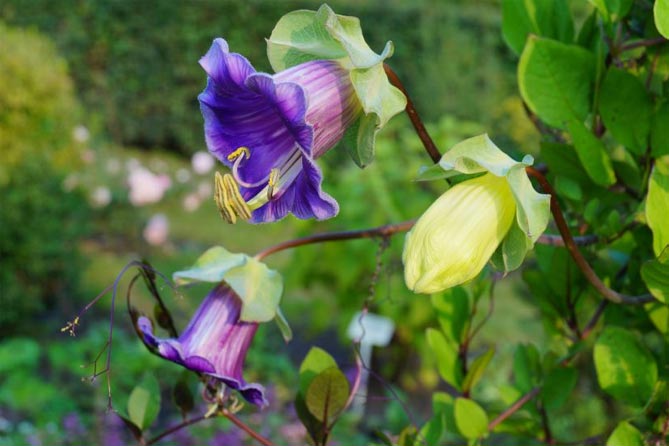

Kobei in garden compositions
Florists love to grow a branchy beauty because of its lush, cheerful appearance.In addition, the vine grows on any surface that it can reach.
Ideas for using creepers in a personal plot:
- If the flower is grown near the fence, then soon it will be possible to notice how the plant occupied the entire hinged area, reliably hiding the site and the house from prying eyes. Moreover, huge purple bells look very impressive at the height of the fence. With the help of an actively growing kobei, you can easily hide the dull, unsightly walls of old buildings.
- If you plant a plant on the south side of the house or near the gazebo, it will tightly surround the existing supports and columns, blocking the house from the outside world with its lush greenery.
- Liana, which cannot stand still and constantly grows, is perfect for the development of a living arch. This decor will be a real decoration for any garden or cottage.
- For landscaping a resting place at a summer cottage, a liana is planted in a stable deep container and powerful supports. The containers with the plant are installed along the perimeter of the garden.
- Kobeya goes well with petunias, lobelia and verbena, making up a bright ensemble even in a gloomy summer cottage.
- With the help of long and pliable branches of the vines, you can profitably zone the site.
Many gardeners consider the kobei to be a rather capricious garden flower. However, people who decide to grow such a flower culture and create comfortable conditions for its development, as a result, get a lush magnificent plant, which becomes the pride of its owner and a real decoration of a flower garden, a garden plot or a balcony.
How to plant kobei seeds?
We offer you to get acquainted with the instructions for growing kobei:
- work with seeds begins in early spring... The bottom of the wooden container is covered with several layers of thick toilet paper or gauze, then this flooring is impregnated with a dilute solution of manganese (potassium permanganate). Vine seeds are placed one at a time at a short distance from each other. The container with the upcoming seedlings is preserved using plastic wrap;
- the place for the container is selected warm, under the indirect rays of the sun... It's okay if the seeds are unexpectedly covered with mucus: in this case, they are washed with a solution of manganese, the wall paper is replaced and clean planting materials are re-placed on it. Gentle seedlings are formed in about 18-21 days. When the sprouts grow up a little, they are planted in a common container;
- the approximate diameter of the total container for plant transplantation is about 9-11 cm... Loose soil is poured into this pot and seedlings are dug in to a depth of 1.6 cm.Each seed is spread horizontally, with the flat side to the bottom. With the formation of the first leaf on the seedlings, it is transplanted into a separate container, not forgetting to set a peg in the ground - a "pack".
- for planting on open ground (mid-spring), seedlings must be prepared in advance... For 16-22 days before disembarkation, the seedlings need to be hardened, for this they put a container for the night on the loggia. This should not be done if there is still frost at night;
- growing quickly, the seedlings are strongly stretched, and this greatly reduces their decorative properties. To create a branchy and lush crown, young shoots need to be pinched;
- for normal acclimatization of a young plant, they select the most closed from drafts and the sunniest area, for example, near the wall of a house or near a fence. Kobei will be able to put up with the lack of sunlight, but the constant shadow will not give the liana an opportunity to show all its beauty during flowering. With the arrival of summer, the planting pits, located at a distance of 80–100 cm between themselves, are filled with sod soil, peat and humus. Saplings are placed here without removing the earthen lump. While weak seedlings have not yet begun to weave, they create a support in the form of pegs. A little later, when the shoots are already getting stronger, the plant will independently be able to climb onto the support installed next to it.
Conditions and care for a kobe after transplanting into open ground
Liana is actively growing and spends a lot of its energy in order to climb upward with its antennae - and it is quite logical that this plant for growing necessarily requires abundant and steady watering, as well as a large amount of nutrients. Especially meeting these needs becomes relevant when summer days are dry and sultry... Moreover, it is always necessary to carefully monitor that after watering the vines, water does not stagnate in the soil, otherwise the root system of the kobei will certainly suffer from the ubiquitous fungal infections.
Kobeya grows quite quickly, but begins to bloom only after weekly baits - it is necessary to start adding fertilizers even from the time of growing young sprouts from seeds in greenhouses. The bait needs to be alternated:
- First, the soil where the kobea grows is saturated with organic fertilizers;
- Then mineral supplements.
At the beginning of the growing season, the plant most of all needs nitrogen, and before flowering (early July) - in phosphorus, potassium and various useful trace elements. The bait must be carefully dosed: if you give the kobei an excessive amount of nitrogen, then the vine will actively release leaves, because of this, the flowering time will significantly decrease. A unique fact: the sour the soil, the brighter the red color the inflorescences of the plant acquire, if there is a lot of lime in the soil, then the blue color predominates in the flower petals.
Trunk soil circles certainly mulch with sawdust, peat or any other material, towhich is organic in order to be able to control the degree of humidity.
Kobei is strongly "loved" by all kinds of garden pests, including spider mites and aphids, so this plant must be frequently examined and treated with insect repellents, if necessary.
Wintering kobei
As we said above, a tropical liana is grown in our conditions as an annual plant, especially since it is quite simple to grow a beautiful liana from a small amount of seeds. At the same time, some summer residents manage to preserve this shrub in winter, so that when the spring frosts leave, there will already be an adult, last year's plant on the backyard.
This is actually a challenge to nature itself: organizing the wintering of a kobee and not destroying it is a rather difficult task, since this plant is, first of all, quite large, and the vine does not take root very well after transplantation. However, this emotional shake-up is only good for the plant. As practice has shown, the kobei, having coped with the winter, begins to bloom earlier and does it quite actively.
How to keep kobei in winter?
With the onset of autumn, at the end of September, all foliage is removed from the plant and carefully dug out. The most important thing is not to damage the roots - the root system, although quite large, is very fragile. Store the plant itself in a container, placing it in a cool and dark room at a temperature of at least 9-11C. The cellar is most suitable for this.
In winter, the kobei is in a dormant state, and this plant does not require care. Periodically, it is necessary to check the ground in which the roots of the vine are located, controlling its normal moisture level. With the onset of spring, the plant is moved to a warm and bright place., slowly increasing the amount of watering the vines. The plant is returned to its original place on the personal plot at the beginning of summer, when the insidious frosts will already be far behind. Care and planting of the kobei, which managed to endure the winter, are the same as for annual plants.
In mother plants that were able to overwinter, cuttings are cut for vegetative propagation of the bush.When, after wintering, the plants begin to form young shoots under the influence of heat and sunlight, the strongest of them is prepared for this purpose: they are carefully cut so as not to deform the mother plant, and stored in wet sand until the shoots create their own root system ... Young seedlings are transferred to open land when good weather normalizes.
Florists who have been growing this climbing liana for a very long time talk about one unique feature: the cobe, which is grown not from seeds, but from cuttings, begins to bloom earlier, but not as brightly and actively as the one grown from seeds.
Growing kobei in garden compositions
Florists like to grow the "branchy" beauty for its cheerful, lush appearance and significant growth on any surface where only the liana can get. Here's how you can refresh and refine your home garden with the help of kobei:
- If you grow a kobei next to a fence, then the plant will occupy it in a very short time, hiding the house and the area from prying eyes. The large bells of this plant on a high fence look quite impressive.
- With the help of a wildly growing kobee, you can easily hide the unsightly and dull walls of outbuildings.
- The plant planted near the gazebo near the southern side of the house will wrap a dense canopy around the supports and block the house from the outside world with a lush green wall.
- The highlight of the infield will be a green living arch - this is exactly what this vine needs, which, it seems, cannot stand still for a second - it is constantly growing!
- In order to plant greenery at the resting place at the summer cottage, the kobei is placed in a deep, stable container with large supports and installed along the perimeter of the garden.
- In a large flower garden, the kobei will make a splendid company of lobelia, petunia and verbena.
- With the help of the pliable and long branches of this plant, you can beautifully divide the area into different zones.
For many gardeners, the kobei is a rather capricious home flower. But those people who have decided to grow this flower crop, and will create the right care for it, will be able to get a magnificent plant as a result, which will decorate a flower garden on a balcony or a personal plot.
Planting seeds
When the preparatory stage has been successfully completed, you can start planting planting material to obtain seedlings. Usually, the seeds of the climbing kobei are planted in late February or early March. A separate cup must be prepared for each seed. This is necessary in order not to carry out the first pick, since this process often turns out to be quite traumatic for the plant. You do not need to prepare any special soil for planting. It is enough just to purchase a universal substrate in a specialized store. The seeds are laid out directly on the surface of the substrate, and sprinkled on top with a one and a half centimeter layer of the same substrate. If you managed to completely clear the cobe seeds from their dense skin, then in two weeks you can expect the first shoots. If this was not done, then you will have to be patient.
General information
The name "kobei" comes from a Spaniard who was a Jesuit monk. His name was Barnabas Cobo, he spent many years in Peru and Mexico. If you want to find a kobei in the wild, then you have to go to the tropics and subtropics of the American continent. This plant entered the culture back in 1787. In those days, as now, it was used for the purpose of vertical gardening, beautiful hedges were created.
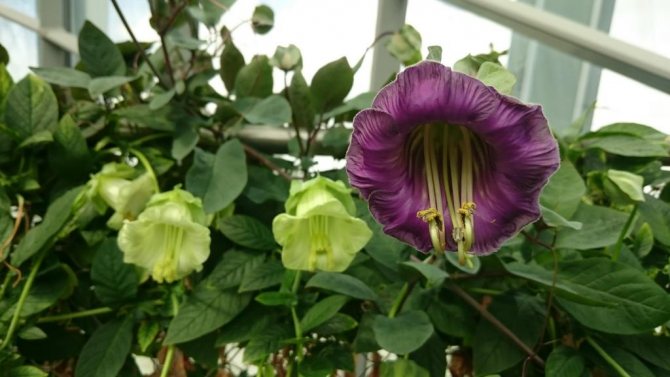

Kobei: photo and description
The plant is characterized by long, above 7 m, stems, on which complex feathery leaves are in the next order, and the tips of the branches are complemented by tenacious tendrils, due to which the flower can detach itself from the ground on its own, clinging to any base. Kobei grows rather quickly, in a short time, decorating huge areas with natural cover.
The plant blooms with large (about 9 cm in size) "bells", which create a pleasant musky aroma: during the growing season, long pedicels form from axillary leaves, which are crowned with single or group of 3-5 flowers with a large pistil and stamens. Young leaves of the inflorescence first have a yellow-green tint, then the flower turns purple or white (depending on the type of kobei). The fruits of this plant are capsule-like, which are leathery and firm to the touch, filled with small, round seeds.
If the sun will often pamper the plant with its warmth and light, then the kobei will surely reciprocate it: in excellent weather, the flower grows surprisingly quickly. Moreover, the fibrous powerful roots of the flower actively use nutrients from the environment.
In his family kobei there are 9 varieties, of which only one variety has taken root in ornamental gardening, which is also called kobei creeping, or, as it is also called, "monastery bells". This type of plant is successfully grown as an elegant decoration of a personal plot.
Features of planting kobei
The growth stage of a kobei from seed to a beautifully growing liana can be roughly divided into two main processes:
- at the initial stage, kobei seeds are planted for seedlings;
- at the next stage, the germinated seeds are transplanted into the ground.
Tropical "living" determined the main character trait of this plant: the kobei does not tolerate negative temperatures, therefore it is cultivated as an annual plant. You can get this beauty on your personal plot only by planting kobei with seeds.
Kobeya in the garden: photos of plants on the site
What do you need to know?
A feature of Cobaea scandens is not only high decorativeness, but also its structure. A powerful root system ensures nutritious nutrition and growth. The stem is branched, with feathery leaves of a deep green color on it. At the end of each shoot there are antennae - these are modified leaves that help the liana to rise and gain a foothold at a height.
The flowers are bell-shaped and are colored purple, burgundy, lilac or white. Can be placed singly or in pairs. The liana blooms until the first frost, exuding a pleasant musky-honey aroma. After flowering, fruits are formed - boxes. They contain large, flat seeds.
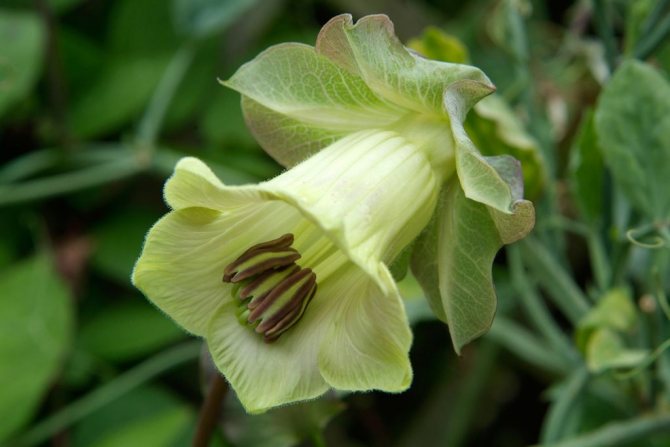

Cobaea scandens alba
1. Seven Secrets of Success:
| 1. Growing temperature: during spring and summer - the usual room temperature or slightly higher, in winter - a cool dormant period at a temperature of about 7 - 10 ° C. |
| 2. Lighting: do not expose the plant to direct sunlight during the daytime in spring and summer, kobei can only bathe in the sun in the morning or evening. |
| 3. Watering and humidity: Plants prefer uniform, abundant watering during the warm season and rare - in autumn and winter, during the dormant period. The air in the room should be sufficiently humid, especially when kept warm. |
| 4. Pruning: Pinch the tips of young stems to encourage the development of side shoots, trim the stems one third of their length in February to maintain a neat and compact shape. |
| 5. Priming: well-drained, nutrient-rich soil with excellent drainage and high content of coarse river sand. |
| 6. Top dressing: only in spring and summer - apply fertilizer every 2 weeks, in the fall the frequency of fertilizing is reduced and the flower is stopped during the winter. Fertilization is resumed in the spring. |
| 7. Reproduction: sowing seeds in spring in a moist and loose substrate or vegetatively - using stem cuttings. |
Botanical name: Cobaea.
Family... Cyanotic.
Origin... Peru and Mexico.
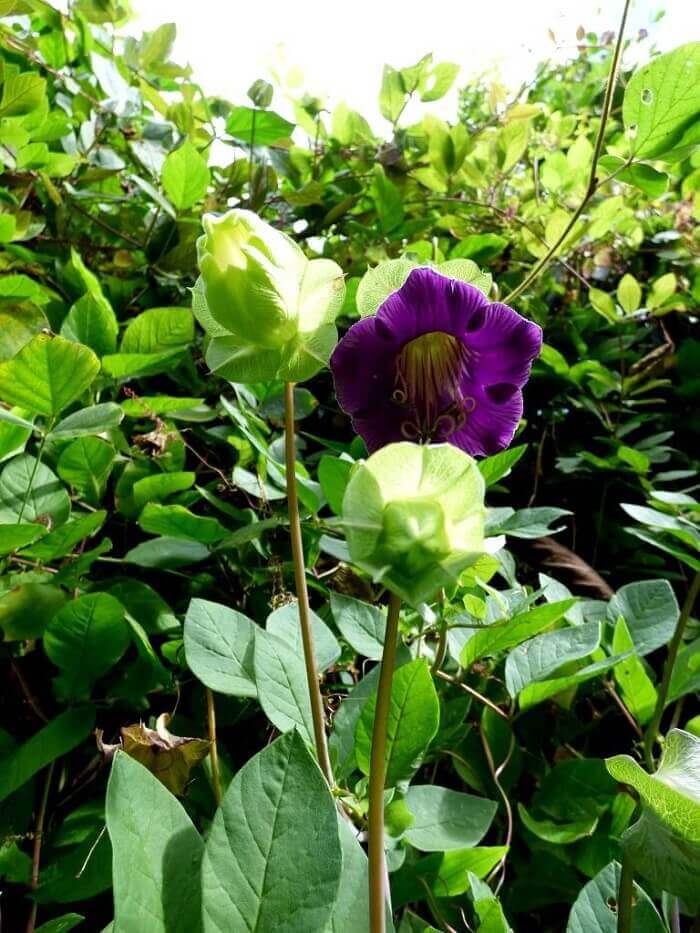

Description... Fast growing liana with complex leavesconsisting of 4 - 6 green, bluish-green lanceolate leaves.
The plant has branched antennaethat help him to cling to the support. Antennae are located in the upper part of the stems and are modified leaf blades.
Flowers large, up to 8 cm in diameter, single or collected in small axillary inflorescences of 2 - 3 buds, very much like bells. At first, the flowers have light shades - greenish, white or cream, but as they wilt, they become darker - blue, pink, purple or burgundy, have a musky scent... The aroma of flowers intensifies in the evening and at night.
Flowers are often completely hidden by foliage.
After flowering, the kobei forms rather large, four-leaved seed pods oblong with large seeds. Perennial plants.
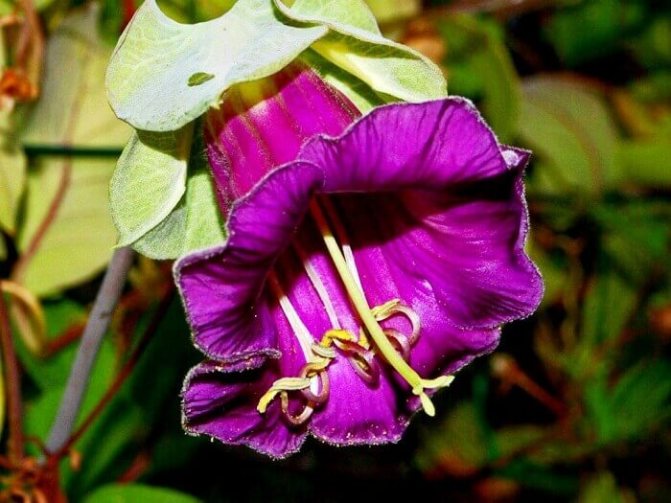

Height... Reaches a height of 10 m in nature. In culture, rarely exceeds 2 m... It develops quickly - shoots reach heights of 5 or more meters in just one season.
↑ Up,
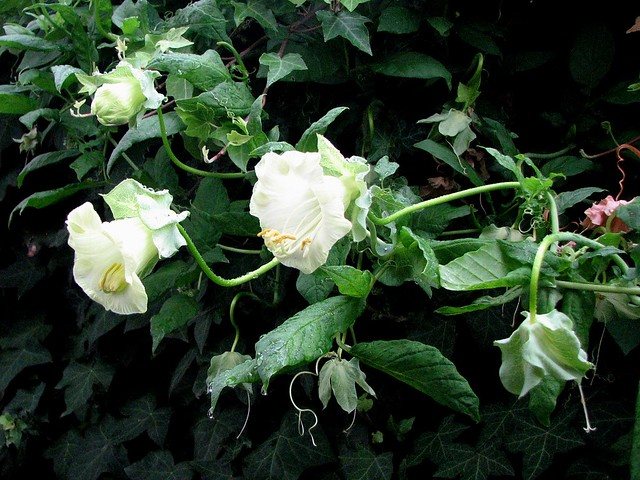

Annual or perennial
In Russian conditions, it is very difficult to grow a kobei as a perennial. Only the most desperate fanatic gardeners succeed in this. It is much easier to buy new seeds every year. But if you still want to go further, use a simple recipe for preserving an existing plant for the next summer:
- in mid-October, carefully cut the stalks of the kobei with a sharp garden knife;
- dig up the liana with the roots;
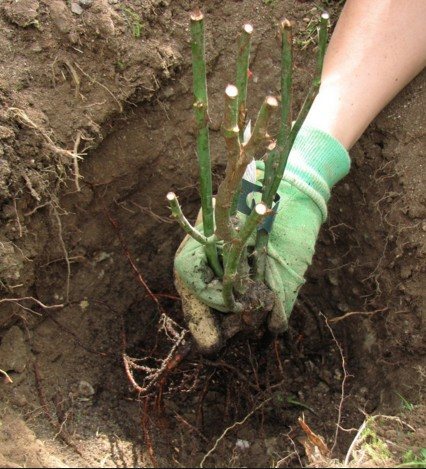

Digging up kobei for the winter
- place in a spacious container along with the soil on the roots;
- place the container in the cellar (without frosty air, but so that there is moderate humidity);
- in this way, the climbing kobe will be able to winter safely;
- around mid-March, remove the container and start watering the plant indoors;
- when warm days begin, plant it back in the soil.
Remember that growing flowers requires attention and responsibility. As for the climbing kobei, we can say that it is a rewarding job - to prepare seedlings, plant them in the ground and take care of the plant. In return, you get an original landscape design, a great way to decorate architectural elements and satisfaction from the work done.
Transfer
Kobei flowers, planting and caring for which require certain skills from the gardener, are easier when using special growth stimulants. Otherwise, it will be difficult for the germ to break through the shell. When the first shoots appear, a container for planting and soil should be prepared. You can use plastic cups for this.
Water the sprouts abundantly. Then the foil is unrolled. An escape with a lump of earth must be carefully removed from the greenhouse soil. Care must be taken to ensure that the roots are not damaged. This will significantly slow down the growth of the vine. Foil molds allow you to do this as accurately as possible.
The transplant substrate should be loose and light. It should contain enough nutrients. After transplanting, you need to give the sprouts time to adapt. After that, you can begin to gradually harden the sprouts.
Top dressing
Kobei needs frequent feeding. Fertilizers must be applied every week. They should contain a lot of nitrogen, and phosphorus and potassium will also be needed during the bud formation period. The first fertilizers are applied already at the time when the kobea was just beginning its life path. With the appearance of the first leaf, the plant needs humate. Next, you should alternately apply organic and mineral fertilizers. As the first, infusion of mullein is excellent, and from the second, you can choose "Kemira". Such alternations are carried out until the climbing cobea blooms.
Do not forget to loosen the soil and remove the weeds around the plant. These are also very important points for caring for a kobe.
Gardeners' recommendations
The kobei climbing flower is considered a perennial plant. If the grower is unwilling to seed it again next spring, he can keep it in greenhouse conditions. After the end of flowering vines in October, the plant must be dug up. This is done very carefully so as not to damage the roots.Then it is transplanted into a bulk container.
Liana is installed in a dark and cool place. The room temperature should not exceed 10 ° C. This could be a dry cellar. Here the kobei will spend the winter. Watering is done once a month. In this state, the vine does not require feeding. In March, it can be taken out of the cellar and transferred to a warm room. Also, the plant will need a lot of light during this period.
Increase watering. After a while, the first leaves will appear on the shoots. During this period, attention is paid to nitrogen fertilizers. When the kobea begins to grow, you can take cuttings for transplanting. They are carefully cut from the vines. They take root by early June. Such a kobea will bloom faster. However, there will be more buds on a seed-grown plant.
If the plant develops poorly, then it is not satisfied with the growing conditions. Perhaps there is not enough light, moisture on the site, or, conversely, the gardener waters the vine too often. The reason for this condition of the kobei should be identified. Many unfavorable factors can be eliminated.
Having considered what features the kobei flower has, every gardener will be able to independently grow a lush, beautiful liana with stunning, luxurious buds. It will decorate any site, delighting its owners with flowering almost to the very frost.



